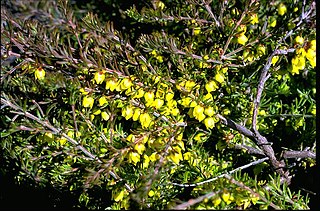
Eremophila dichroantha, also known as bale-hook eremophila, is a flowering plant in the figwort family, Scrophulariaceae and is endemic to the south-west of Western Australia. It is a shrub with many ascending branches making the plant appear broom-like. It has small, hooked leaves and small, though abundant, violet to lilac-coloured flowers.

Grevillea asteriscosa, commonly known as star-leaf grevillea, is a species of flowering plant in the family Proteaceae and is endemic to the south-west of Western Australia. It is a shrub with widely-spreading branches, star-shaped leaves with sharply-pointed lobes, and bright red flowers.

Eremophila calorhabdos, commonly known as red rod or spiked eremophila, is a flowering plant in the figwort family, Scrophulariaceae and is endemic to the south-west of Western Australia. It is a distinctive shrub with erect, rod-like branches up to 2.5 m (8 ft) high, leaves with small teeth along the edges, and flowers that change from orange to lipstick pink as they open.

Eremophila ionantha is a flowering plant in the figwort family, Scrophulariaceae and is endemic to Western Australia. It is a shrub with many sticky branches, narrow, light green leaves and blue, purple or violet flowers.
Hakea pritzelii is a flowering shrub in the family Proteaceae and is endemic to a few small areas in the Great Southern region of Western Australia. It has rigid, pale green leaves and scented red-purple flowers.
Verticordia muelleriana is a flowering plant in the myrtle family, Myrtaceae and is endemic to the south-west of Western Australia. It is an openly branched shrub with relatively large, egg-shaped to circular leaves and long spikes of deep maroon coloured flowers in spring and early summer.
Verticordia stenopetala is a flowering plant in the myrtle family, Myrtaceae and is endemic to the south-west of Western Australia. It is a low shrub with small leaves and heads of pink to magenta-coloured flowers in late spring and early summer.
Baeckea elderiana is a species of flowering plant in the family Myrtaceae and is endemic to central Western Australia.
Baeckea grandibracteata is a species of flowering plant in the family Myrtaceae and is endemic to central Western Australia. It is an erect to spreading shrub that typically grows to a height of 0.15 to 0.9 metres and blooms between September and December producing pink and white flowers. Found on undulating sand-plains in the eastern Wheatbelt region of Western Australia in the area around Yilgarn, it grows in sandy and sandy loam soils.
Baeckea grandis is a species of flowering plant in the family Myrtaceae and is endemic to the south-west of Western Australia. It is an ascending to low-lying shrub that typically grows to a height of 0.1 to 0.5 metres and blooms between September and December producing pink and white flowers. Found on sand-plains and hills in the Mid West and northern Wheatbelt regions of Western Australia, it grows in sandy and lateritic soils.
Conothamnus neglectus is a member of the family Myrtaceae endemic to Western Australia. This open shrub typically grows to a height of 0.2 to 1.0 metre. It blooms in between July and September producing yellow flowers.
Conospermum eatoniae, commonly known as blue lace, is a shrub endemic to Western Australia.

Boronia purdieana is a plant in the citrus family, Rutaceae and is endemic to the south-west of Western Australia. It is a shrub with pinnate leaves and yellow, four-petalled flowers arranged singly in leaf axils.
Goodenia eremophila is a species of flowering plant in the family Goodeniaceae and is endemic to inland areas of Western Australia. It is an ascending herb with linear to elliptic leaves and thyrses of blue flowers.
Goodenia nuda is a species of flowering plant in the family Goodeniaceae and is endemic to the Pilbara region of Western Australia. It is an erect to ascending herb with elliptic to lance-shaped leaves at the base of the plant, and racemes of yellow flowers.

Bossiaea leptacantha is a species of flowering plant in the family Fabaceae and is endemic to southern Western Australia. It is a low, compact, spreading, many-branched shrub, the branches ending in cladodes, the leaves reduced to small scales, and with deep yellow, red and greenish yellow flowers.

Daviesia decipiens is a species of flowering plant in the family Fabaceae and is endemic to the south-west of Western Australia. It is an intricately-branched shrub with scattered, sharply-pointed oblong or tapering phyllodes, and orange, maroon and crimson flowers.

Daviesia dielsii, commonly known as Diels' daviesia, is a species of flowering plant in the family Fabaceae and is endemic to the south-west of Western Australia. It is on intricately-branched shrub with sharply-pointed, egg-shaped, vertically compressed phyllodes, and yellow and red flowers.
Lasiopetalum dielsii, is a species of flowering plant in the family Malvaceae and is endemic to the south-west of Western Australia. It is a spreading shrub with hairy stems, heart-shaped leaves and pink or white flowers.
Baeckea staminosa is a species of flowering plant in the family Myrtaceae and is endemic to the south-west of Western Australia. It is a spreading shrub that typically grows to a height of 25 cm (9.8 in) and is found in wetlands in the Geraldton Sandplains biogeographic region.








